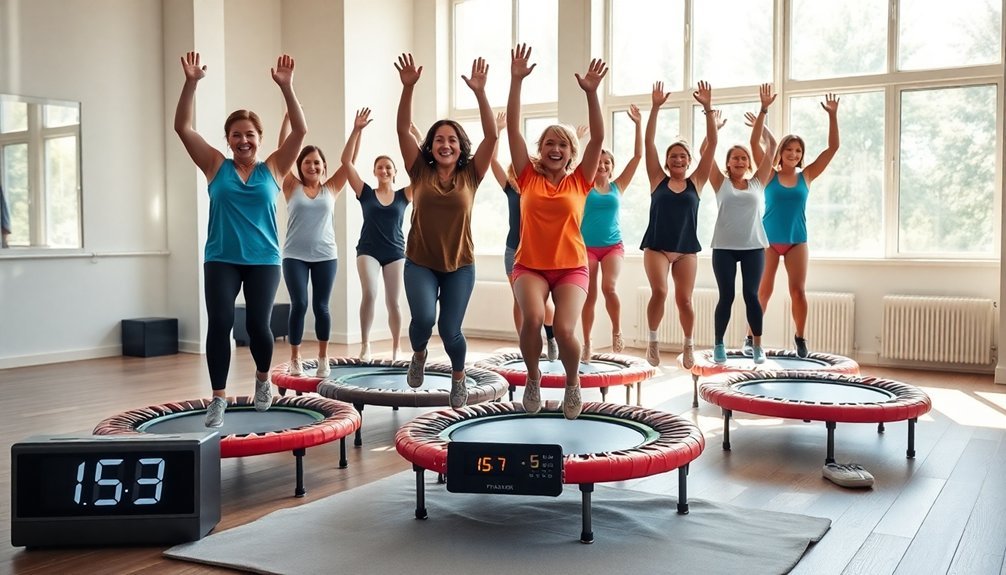Rebounding offers a low-impact, highly effective cardio workout that's perfect for beginners. Start with basic bounces, health bounces, and gentle jogs on your mini-trampoline for 5-15 minutes daily. Add arm movements like punches and circles to engage your upper body, and gradually incorporate jumping jacks, high knees, and twists as your confidence grows. Always warm up with gentle bounces and cool down with stretches. The complete 10-workout system awaits below to transform your fitness journey.
What Makes Rebounding Perfect for Cardio Beginners

When considering cardio exercises as a beginner, rebounding stands out as an exceptional choice. This low-impact activity reduces joint stress while delivering impressive cardiovascular benefits by increasing your heart rate and improving blood circulation.
You'll find rebounding accessible regardless of your fitness level, with the ability to gradually increase intensity as you progress. The gentle bouncing motion stimulates your lymphatic system, supporting detoxification and boosting immune function.
Beyond physical benefits, you'll experience stress reduction through the release of endorphins, enhancing your mood while working out. Your balance and coordination will improve as you bounce, engaging multiple muscle groups simultaneously.
Bouncing your way to better mental health while strengthening your body with each gentle jump.
The best part? Rebounding burns calories efficiently while being gentler on your body than high-impact exercises like running. Studies have shown rebounding is 68% more effective than jogging for cardiovascular conditioning while putting less strain on your joints.
Essential Equipment for Safe Rebounding Sessions
Three vital pieces of equipment form the foundation of every safe rebounding workout: a quality rebounder trampoline, appropriate safety accessories, and a properly prepared environment.
Invest in a rebounder with patented arched legs and elastic cords that offer a smooth, low-impact bounce. Look for models with adjustable tension to customize your experience. For beginners, safety bars or handles provide essential balance support as you build confidence. Consider wearing cotton socks for optimal grip on the mat surface.
Before each session, place your rebounder on a level, non-slip surface away from obstacles, with ample overhead clearance. Check that all legs are securely attached and the mat is clean and dry.
Perform a quick stability test with a light bounce to verify everything functions properly. Regular maintenance and pre-workout inspections will extend your rebounder's life and keep your cardio sessions safe.
The 5-Minute Warm-Up Routine for New Bouncers

A proper warm-up forms the cornerstone of any effective rebounding workout, especially for beginners new to this bouncy form of cardio.
Start with your feet hip-width apart, knees slightly bent, and core engaged. Begin with gentle bounces, letting the balls of your feet press into the rebounder while keeping your spine neutral.
Proper stance creates a foundation for safe rebounding—hip-width feet, soft knees, engaged core, and neutral spine.
For five minutes, gradually increase your intensity. Start with 60 seconds of basic bounces, then add gentle arm movements to elevate your heart rate. Incorporate side steps to improve balance before returning to controlled bounces. Maintaining a heavy tailbone pointing down will help engage your core muscles properly throughout the warm-up.
Focus on your breathing rhythm throughout. This low-impact warm-up stimulates your lymphatic system, improves circulation, and prepares your body for more challenging moves.
Remember to maintain proper alignment and adjust the pace to suit your fitness level.
Basic Bounce Variations to Build Cardio Endurance
Start with small, controlled bounces that gradually increase in height as your stability improves over several sessions.
You'll want to monitor your heart rate, aiming to stay between 50-70% of your maximum for effective cardio development as a beginner.
As you become more comfortable with the basic bounce, you can extend your workout time from 5 to 15 minutes while maintaining proper form.
Using a T-shaped handlebar can provide additional stability while you learn proper rebounding techniques for cardio fitness.
Bounce Height Progression
Mastering your bounce height progression forms the cornerstone of effective rebounding workouts for beginners. Start with a low-impact bounce, focusing on core engagement and slightly bent knees to properly absorb impact. As your confidence builds, gradually increase height by applying more explosive force through your feet. This technique mimics the controlled landing mechanics used in box jumps, where focusing on landing softly reduces impact on joints.
| Height Level | Technique Focus |
|---|---|
| Beginner | Core tight, gentle knee bend |
| Low | Controlled breathing, hip alignment |
| Medium | Increased knee action, shoulders relaxed |
| High | Explosive foot push, maintaining alignment |
| Advanced | Variable rhythms, full body coordination |
Always maintain proper alignment with hips slightly back and shoulders relaxed. Your knees should never lock—keep them soft to prepare for landing. Remember to practice controlled breathing as you increase height, which enhances both your endurance and bounce rhythm while preventing early fatigue.
Heart Rate Zone Training
Understanding heart rate zone training revolutionizes how beginners approach their rebounding workout routine. By exercising in zones 1-3 (60-83% of your maximum heart rate), you'll maximize cardiovascular benefits while maintaining safety.
Start with basic bounces at zone 2 (61-70%), similar to power walking intensity, where you'll notice slightly increased breathing. This "fat-burning zone" is perfect for 20-40 minute sessions as you build endurance.
As you progress, incorporate side-to-side or front-back movements to challenge yourself while maintaining low impact. Tracking your workout intensity through real-time heart-rate monitoring helps you make necessary adjustments during your rebounding session.
Monitor your heart rate using technology to guarantee you're working at appropriate intensities. Remember to gradually increase your workout difficulty and always cool down properly to prevent sudden heart rate drops.
This personalized approach makes rebounding accessible and effective, regardless of your starting fitness level.
The 15-Minute Beginner-Friendly Rebounding Circuit

You'll want to start your rebounding journey with shorter intervals of 30-60 seconds per movement to build endurance without overwhelming your body.
As your comfort level increases, gradually extend your bounce time to 90 seconds or two minutes per exercise.
Timing your intervals with a fitness app or timer keeps your circuit structured and helps you track improvements in your stamina over weeks of consistent practice.
Remember to maintain soft landings rather than focusing on jump height to protect your joints while maximizing the trampoline's benefits.
Start Slow, Build Strong
When first stepping onto a rebounder, your body needs time to adapt to this unique form of movement. Begin with the basic bounce, maintaining proper posture while engaging your core. Focus on ankle warm-ups and heel-to-glute stretches to prepare your joints.
As you gain confidence, introduce gentle hip twists and imaginary jump rope motions. These movements activate your calves and improve coordination without overwhelming your system. For optimal alignment, position your feet wider than hips with a slight bend in the knees, creating a mini squat stance.
When you're ready to increase intensity, try double jumps and knee lifts while keeping your knees slightly bent.
Don't rush the process. Incorporate stability bounces and wide stance jumps to strengthen your core and balance.
Always end your session with gentle bounces and stretching to prevent soreness. Consistent practice will boost your cardiovascular health while keeping impact low on your joints.
Timing Your Bounce Intervals
The perfect rebounding workout balances intensity with recovery, especially for beginners just discovering this bouncy form of cardio.
Start with a 15-20 minute circuit that won't overwhelm your system while still delivering cardiovascular benefits.
Begin with a 2-5 minute warm-up of gentle bouncing to prepare your muscles. Then structure your intervals with 45 seconds of active bouncing followed by 15-20 seconds of rest. This timing maximizes effectiveness while preventing burnout.
Include basic moves like the foundational bounce, side-to-side jumps, and knee lifts to build your rebounding foundation. This structure follows proven formats like Michelle's workout which incorporates timed intervals for optimal intensity management. Aim to practice 2-3 times weekly, allowing your body adequate recovery between sessions.
Always finish with a 1-3 minute cool-down stretch to improve flexibility and help your muscles relax after the workout.
Proper Form Techniques to Maximize Cardio Benefits
Mastering proper form on a rebounder isn't just about safety—it's vital for maximizing your cardiovascular benefits during each session. Keep your knees slightly bent and distribute weight evenly between your heels and toes to maintain balance and proper joint alignment.
Engage your core muscles throughout your workout to stabilize your position and protect your lower back. Consider using the safety handle for balance support during more challenging exercises or when you're first starting out. Maintain a slight forward hinge at the waist while keeping your focus ahead rather than looking down at the trampoline surface.
When performing high-intensity moves like jumping jacks or high knees, make certain you're maintaining this proper alignment to effectively elevate your heart rate.
As you progress, increase jump height and speed gradually rather than immediately pushing for maximum intensity. Remember to warm up first and cool down afterward to prevent injury and enhance recovery.
Combining Arm Movements for Full-Body Engagement
Adding arm movements to your rebounding routine transforms a simple bounce into an extensive full-body workout.
Try incorporating punch-bounce combinations, gentle arm circles while maintaining your bounce, or coordinated cross-body movements to engage your upper body muscles.
These coordinated movements not only boost your calorie burn but also improve your balance and rhythm on the rebounder. For maximum effectiveness, consider adding lateral raises to your routine which can help develop shoulder definition while you bounce.
Punch-Bounce Combination Patterns
Combining bouncing movements with punching patterns creates an excellent opportunity to maximize your rebounding workout's effectiveness. These combinations engage your full body while delivering impressive cardiovascular benefits with minimal joint impact.
Start with alternating single arm punches during each bounce to develop coordination. As you gain confidence, progress to more dynamic patterns like double punches with jumping jacks or four-punch combinations during bounce intervals.
For added core engagement, incorporate hip twists with your punches. To keep your workout challenging, try adding elbow movements or integrating boxing-inspired footwork like the pendulum step. These punch-bounce patterns provide a low-impact nature that reduces stress on joints while still delivering an effective cardio workout.
Remember to maintain proper posture throughout and engage your core to stabilize your movements. Using upbeat music can help you maintain rhythm while making these combinations more enjoyable.
Arm Circles While Bouncing
Arm circles represent one of the most versatile and effective upper body movements you can incorporate into your rebounding routine. They engage multiple muscle groups in your shoulders and upper back while improving flexibility and reducing injury risk.
To perform them correctly, stand with feet shoulder-width apart on your rebounder, engage your core, and extend your arms parallel to the ground. Start with small circles, gradually increasing size and speed as you warm up. Remember to breathe naturally—inhale as your arms rise, exhale as they lower.
Try alternating between forward and backward circles for balanced muscle development. This approach mimics the traditional arm care routine of palms down going forward and palms up going backward for optimal conditioning. For an added challenge, introduce light weights or coordinate your arm movements with your bouncing rhythm.
This combination transforms a simple cardio session into a full-body workout that maximizes calorie burn.
Coordinated Cross-Body Movements
Cross-body movements represent the next level in your rebounding journey, where you'll synchronize arm and leg actions to maximize workout efficiency.
Try combining punches with kicks while bouncing to boost your cardiovascular endurance and engage multiple muscle groups simultaneously.
For beginners, start with jumping jack variations by adding simple arm movements to enhance calorie burn. Each exercise should be performed for 30 seconds before moving to the next movement in your routine.
The toy soldier movement—alternating heel lifts with arm swings—improves coordination while stimulating lymphatic circulation.
When ready for more challenge, incorporate opposite hand-to-knee taps or speed skater movements that mimic ice skating.
These exercises not only improve your balance and coordination but also increase cardiovascular health while reducing stress.
Remember to maintain proper form, engage your core, and progress gradually.
If needed, use support until you've built confidence with these coordinated movements.
Progressive Intensity: When and How to Challenge Yourself
As you become more comfortable with basic rebounding movements, it's time to contemplate how and when to increase your workout intensity.
Start by gradually incorporating new challenges every few weeks once basic bounces feel manageable.
You can progress in several ways: change movement patterns, extend workout duration, or add HIIT intervals with movements like high knees and jumping jacks.
Monitor your progress by tracking heart rate improvements and increased workout stamina.
Prioritize safety by using quality rebounders and maintaining controlled movements.
Self-pace your workouts, modifying exercises as needed—reduce jump height or use support bars if necessary.
Include strategic rest periods to manage heart rate and prevent burnout.
Remember to always warm up before and cool down after higher-intensity sessions to protect your joints and prevent injury.
For more structured progression, consider following workout programs like the 38-minute Beginners Rebound Progression which offers variations suitable for different fitness levels.
Cool-Down Stretches for Post-Rebounding Recovery
While the exhilaration of bouncing might tempt you to end your workout abruptly, dedicating time to cool-down stretches after rebounding is essential for ideal recovery. Stretching immediately after exercise when muscles are warm maximizes flexibility and reduces injury risk.
Hold each stretch for 20-30 seconds, breathing steadily throughout, and repeat 2-3 times.
| Stretch | Target Area |
|---|---|
| Child's Pose | Back & Shoulders |
| Butterfly Stretch | Hips & Inner Thighs |
| Calf Wall Stretch | Lower Legs |
| Happy Baby Pose | Lower Back & Hips |
Focus particularly on your calves and ankles which absorb significant impact during rebounding. For a complete recovery routine, incorporate stretches that target your core and hip flexors. Consider using a yoga strap to enhance your stretching capability and reach during more challenging poses. Stay hydrated throughout your cool-down to support muscle recovery.
Creating Your Weekly Rebounding Schedule for Consistent Results
Creating a consistent rebounding schedule stands as the cornerstone of achieving meaningful fitness results, especially for cardio beginners. Start with short daily sessions rather than infrequent longer workouts—consistency trumps duration every time.
Begin your week with basic bounces on Monday to establish proper form, then gradually incorporate variety throughout the week with movements like high knees and side steps. Schedule sessions for both morning and evening when possible, keeping workouts brief but regular. For optimal benefits, aim to rebound every day as this maximizes the positive effects on your lymphatic system and overall fitness.
Listen to your body and include rest days as needed, focusing on light stretching rather than intense bouncing. As your endurance improves, gradually increase session length while maintaining proper form.
Remember to check your rebounder's condition regularly and stay hydrated throughout all workouts.
Frequently Asked Questions
Can Rebounding Help With Specific Health Conditions Like Arthritis?
Yes, rebounding can help with arthritis by providing low-impact exercise that improves joint function, reduces pain, stimulates your lymphatic system, and enhances balance. You'll want to start slowly and consult your doctor first.
How Does Rebounding Compare to Traditional Cardio for Calorie Burning?
Rebounding burns calories more efficiently than traditional cardio, being up to 68% more effective than treadmill running. You'll burn 6.9-12.4 calories per minute while enjoying lower impact on your joints.
Is Rebounding Safe During Pregnancy or Postpartum Recovery?
During pregnancy, rebounding isn't recommended due to balance risks, but postpartum it's great for recovery. You'll need doctor clearance before starting either way—six weeks post-vaginal delivery or 12 weeks post-cesarean is typical.
Can Children Safely Use Adult Rebounders for Exercise?
Yes, children can safely use adult rebounders, but you'll need to supervise them closely. Make certain they understand it's not a toy and choose rebounders with safety features like non-slip mats and protective flaps.
Will Rebounding Make Existing Joint or Back Pain Worse?
While rebounding is generally low-impact, it may not worsen your existing joint or back pain if you start gradually, maintain proper posture, and use quality equipment. Always consult your healthcare provider before beginning.
In Summary
You're now equipped with 10 effective rebounding workouts to kickstart your cardio journey. Remember, consistency matters more than intensity at this stage. Start with just two sessions weekly, gradually increasing as your confidence builds. Don't forget to track your progress and celebrate small wins. With your mini-trampoline and these beginner-friendly routines, you'll bounce your way to better fitness in no time.





Leave a Reply